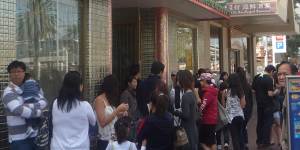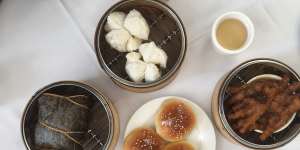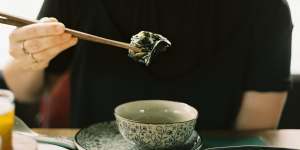I laughed and apologised. As someone who’s eaten dim sum his entire life,going out for dumplings,steamed buns and cups of tea just seemed normal,as it would for almost anyone with southern Chinese heritage. I didn’t twig that someone with Petar’s European background wouldn’t be exposed to dim sum unless someone showed him.

Weekend queues have long been a feature outside Six Fortune,Canton Bay and other dim sum restaurants in Northbridge and suburbia.Max Veenhuyzen
So when I wrote last week’s review on,I might have made some assumptions about readers’ (collective) familiarity with dim sum and how it works.
And when people get confused,they tend to freeze. Which in this instance,might mean not going to Canton Lane (which you definitely should) or taking a step outside their comfort zone and trying dim sum for the first time.
They definitely should – so here’s a little primer on one of the planet’s great eating experiences.
Dim sum is a Chinese meal of small,shared,assorted sweet and savoury dishes. Equally important to the food component is the tea that you drink with it. According to the legends,dim sum evolved from the practice of tea houses serving guests little bites to eat to go with their tea and keep them around for another cuppa. The origins of tapas follows a similar narrative arc,with Spanish bars serving guests a piece of bread or cheese as a lid (“tapa”) for their drink.
Dim sum is also known as yum cha which is a Romanisation of yam cha,Cantonese for “drink tea”. Dim sum translates to “touch the heart” and refers to the dishes that you traditionally eat while drinking tea. While each phrase refers to a different aspect of the experience,both are used interchangeably – at least in Australia – to denote going out for dumplings and tea. In Australia,dim sum is regarded a brunchtime or lunchtime ritual but within the Chinese diaspora,it can also be traditionally taken for afternoon tea,dinner or between meals.
Most dining experiences involve waiting as your food is prepared,but the bulk of the wait at dim sum happens before you sit down,as you wait for a table. This is especially true if you’re trying to eat at prime time,Saturdays and Sundays from 11am-1pm. Reservations aren’t taken,and tables are first-come-first-serve depending on group size. Most places require your entire party to be there before they’ll seat you,especially at peak time. This is why there are crowds of people clutching raffle tickets blocking the Roe Street sidewalk at weekends.
Once you’ve got a table,if you’re lucky,a lady pushing a steamer trolley (their street name is “trolley aunty”) piled with mini bamboo steamer skyscrapers will materialise tableside and you start picking what you’d like to eat. This works smoothest if there’s just one designated person ordering food on the table. If they’re considerate,they would have asked in the queue what dishes people want,or they’ll already know preferences as well as the restaurant’s specialties or weaknesses.
Dishes follow a sliding price scale (S,M,L and XL price points are commonly used) and trolley aunties will mark what you’ve ordered on the bill that’s on your table. Some dishes – usually fried and baked items – will be ferried tableside by staff carrying trays. Some dishes such as fried squid and Chinese greens need to be ordered from staff.
Don’t be alarmed if all this sounds daunting. All us Chinese kids learned how to dim-sum by emulating our parents. Non-Chinese people learn from the Chinese kids. And if you’re rolling solo,watch the tables around you.

Steamed pork bun,sticky rice and chicken’s feet at Fortune Five.Max Veenhuyzen
Speaking of copycat behaviour,my Mum helped sharpen my tea game too. After observing her bring her own pu-erh tea – a smoky,earthy fermented tea synonymous with China’s Yunnan province that cuts through the fattiness and richness of dim sum beautifully – with her to dim sum,I now follow suit,although I’ll usually roll with lighter Taiwanese oolong or a more fragrant tieguanyin instead. Most places are happy to provide guests with pots of hot water at the same per-person price as a pot of tea.
Unless you like really weak tea,don’t pour the tea straight away. Most dim sum restaurants brew tea (jasmine,usually) to order so give the pot time to infuse. Chinese teapots can be treacherous. Pour fast and with steely intent. For others before yourself. Turning the teapot lid upside down or on its side is the signal for “I’m out of hot water and need a top-up”.
Dim sum restaurants and staff operate with a ruthless efficiency that can seem rude. It’s not intentional. Dim sum is a numbers game and the faster guests can be fed and watered and moved on the more guests can come through. Canton Lane,in the interests of fairness,enforces a one-hour seating time for all guests,although I don’t think I’ve seen anyone asked to move along. Be mindful there are people waiting so don’t linger unnecessarily.
You will almost certainly order too much the first few times. The combination of a readily available supply of food plus the inevitable FOMO means dim sum food comas are no joke. If you’ve dragged yourself to dim sum in to revive your spirit after a big night,going straight back to bed is a real danger.

Some dim sum restaurants use squid ink and gold dust to add a contemporary accent to traditional dishes.Max Veenhuyzen
Not that seasoned dim-summers are immune to FOMO. Whether it’s a case of limited quantities,being full,unlucky timing (big kitchens with big repertoires can only prepare so many of any one item at a time) or unlucky placing so you catch a trolley auntie after her stock is depleted,you can’t always get what you want. One solution is to get items as soon as they come by even if you’re not ready,especially things like egg tarts or baked custard puffs that can sit for a while and don’t need to be eatenhot-hot.
Another strategy is to go with a group,so you can order and try more dishes. The only downside to this group dining,perhaps,is splitting the bill,at least in these cashless times and when most restaurants,mindful of credit card company fees,will only accept a single card for payment. Whether you bring some of the folding stuff,get bank account deets,or just take turns paying the bill,assembling a group of friends for a regular dim sum outing is one of the more enjoyable ways you can catch up with pals on the regular.
Start the day with a summary of the day’s most important and interesting stories,analysis and insights..